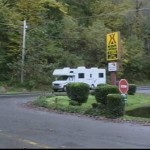When we inspected the 2005 Salem travel trailer my son purchased a few weeks ago we were aware that there had been a water leak around a skylight over the shower-tub.
There was some visible damage to the wall paneling and ceiling. The previous owner shared that he believed the leak had been stopped – he had added sealant around the skylight. From what we could see and feel, we all agreed that the damage was minor and nothing to be overly concerned about.
Boy, were we wrong!
As it turned out the leak had not been corrected and water had been dripping, unseen, into the wall every time it rained. Over a period of several years of rain and leakage, all of the wood behind the wall paneling had rotted away. A section of the roof decking between the skylight and the wall was completely gone (black area in photo).
Fortunately, I have carpentry experience that has been passed down to my son. I also have the needed repair tools for him to borrow. He has completely removed the shower wall, paneling, insulation and all rotted wood and is now replacing them with new components that will be better than new. If he had needed to take it to a RV repair facility, which now charge at least $80 or more per hour, he would have been looking at a couple of thousand dollars as a repair bill.
All of this could have been prevented.
Owning an RV is a big responsibility. It does not make a difference if it is a small pop-up or a huge motor home – the responsibility is the same.
Just like your brick and mortar home, an RV needs care and maintenance. If you are a home owner, you know exactly what I am talking about.
Recreational vehicles, for the larger part, are well made. But, they endure a lot of abuse sitting in the sun, rain, wind and possibly snow and ice.
Most owners do not stop and think about the impact of simply rolling the RV down a highway. Did you know that it is estimated that your RV endures the equivalent force of an earthquake that can measure 5.0? Those forces are constantly twisting, bending and possibly breaking framing and joints. It is a rough ride.
I was once told by an extremely knowledgeable and experienced RV mechanic that it is not a question of “if” your RV will develop a water leak, but “when”.
Water is an insidious chemical. If there is a way it can invade your RV, it will. Small screw holes, cracked seams around roof trim and vents, the edges of doors, windows, lights and compartments are all susceptible to water invasion.
At least once a year your RV needs to have an inch by inch inspection – both over and under. All of the seams and exposed joints need cleaning and re-sealing. Be aware that the screws under the joint trim can rust and provide water access. It is a good idea to pop out the vinyl insert for the trim and put sealant over all the screw heads.
 One of the best sealants to use on and around the EPDM rubber roof on many RVs is a self leveling sealant made by Dicor. This sealant is great for fiberglass and aluminum roofs as well.
One of the best sealants to use on and around the EPDM rubber roof on many RVs is a self leveling sealant made by Dicor. This sealant is great for fiberglass and aluminum roofs as well.
Larger seams that show signs of fatigue or tears in the roof are best repaired with a EPDM sealant tape. I prefer one sold under the name of Eternabond.
 Joints around windows, doors, lights and hatches can be sealed with a silicone chalk available at most any home or hardware store. You may need to clean away any soft protruding putty that was originally used by many RV manufacturers.
Joints around windows, doors, lights and hatches can be sealed with a silicone chalk available at most any home or hardware store. You may need to clean away any soft protruding putty that was originally used by many RV manufacturers.
Joints or seams – like totally removed molding, hatches, doors, etc. should be resealed with Silaprene rather than the OEM “window putty”.

Silapren is an ADHESIVE chalk used on open joints and seams before closing. It has replaced soft “window putty” type chalks on newer RVs.
Most RV manufacturers have gotten away from the use of soft window putty and now use Silaprene. Be sure to clean off ALL of the old exposed window putty before using Silaprene
Tears or rips in the underbelly lining are easily fixed with Gorilla Tape. It is far superior to ordinary duct tape.
 Taking the time to do at least an annual exterior inspection and resealing of any suspect area will extend the life of your RV and possibly save thousands of dollars in lost resale or trade-in value.
Taking the time to do at least an annual exterior inspection and resealing of any suspect area will extend the life of your RV and possibly save thousands of dollars in lost resale or trade-in value.
